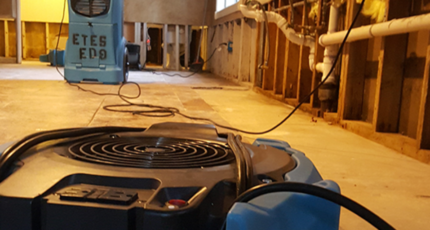
After Hurricane Harvey, we got a lot of calls for people wanting us to remediate their homes. As it turned out, virtually all of these homes needed restoration, not remediation. What’s the difference, you ask?
Technically speaking, remediation is mold treatment in a controlled environment. A flood recovery is anything but a controlled environment. The home’s envelope is open, walls all around the structure are torn out, workers are coming and going, and there is likely contaminated silt from the flood in the space.
Restoration is typically what you see after a flood ravages a house. It’s going to be a tear-out. Generally, we advise taking out 4’ of sheetrock as well as trim, baseboards, etc., all the way around the house.
This also includes porous materials within that first 4’ of the house, including cabinets and insulation, and especially anything against an outside wall. Insulation wicks up water. Cabinets typically rest against outside walls and once flood-soaked, will start growing mold within about 48 hours of being wet. That all goes to the debris pile.
“A lot of people don’t want to demo their cabinets. Many times, you can demo behind them and demo under them and get air movement and all that, but most cabinets are made of pressed board, and basically, that just soaks up the water,” said Marc Patel, owner of Green Star Eco Services.
“Even if you can get air in to dry them out, by the time you get to do that (after a storm flood), there’s already mold growth starting. Especially if it’s against an outer wall, it’s sitting against sheetrock and insulation that just traps the water in there. So, all that stuff has to go,” he added.
Once the tear-out is done, sweep and vacuum the interior (shopvac). At this point, Green Star Eco sprays an antimicrobial solution on the floors and throughout the structure in the demolished areas, including the house framing. We use an eco-friendly sanitizer that kills bacterial and mold. We do not use bleach, which breaks down into a form of food for mold.
After that treatment, we’ll apply air movement with axial fan and air movers, and then dehumidification.
“We have all the dry-out equipment. We have HEPA-air purification equipment. We have three MRCs, which are mold remediation contractors on staff to apply mold remediation principles, which like I said, it’s not a remediation environment, but we know how to treat mold,” Patel said.
The objective is to properly dry out the structure, measuring until the moisture meter readings are below 16-18% on wood and 6-7% on all other porous materials, such as sheetrock and gypsum board. With a storm restoration, it can be easier to get cross-ventilation in the structure to help with the drying out process. Green Star Eco Services follows a FEMA-formula for optimizing the number of fans needed.
“This type of project is what we call restoration,” Patel said.
By contrast, Green Star Eco Services is often called into to perform a remediation within an intact house that suffers from a mold incursion. Remediation is a controlled demolition process that is in place to eliminate the possibility of cross-contamination. This way, the mold is killed in a controlled environment.
Whether it is a flood or a leak, a restoration or a remediation, bear in mind that the state of Texas has licensing requirements for contractors involved in the documentation and treatment of mold. These licenses are split among the respective duties, including mold remediation contractors (like the Green Star Eco Services staff) and mold assessors, who are called upon to document mold damage.
Patel related that after Harvey, a lot of homeowners are asking him “for a clearance document for their home, which I can’t do because I am a remediation company. In Texas, it’s a handoff between a remediator and an assessor.”
The Texas licensing standards are so well-regarded that people from other states seek the credentials from the Lone Star state, Patel noted.
“A lot of people come into Texas to get certified because our rules here are so strict. Bottom line is we have to be licensed to remediate and treat, and to work on mold projects,” he said.
